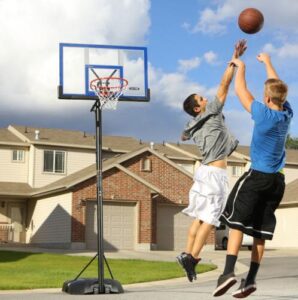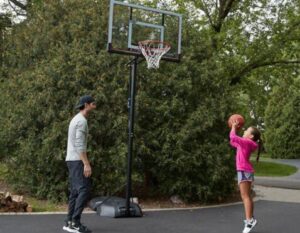Portable basketball hoops are relatively cheap and convenient, so you can establish a backyard or driveway for an entertaining spirited sport of hoops at any time of the day. Since they are moveable, these systems are light and need either sand or water to balance them down.
Want a stable basketball hoop even with less sand or water filled? Check it here:
The most professional hoop with sand filled design for athletics – Spalding Ultimate Hybrid Hoop
Shatterproof hoop with stable base to be filled with water or sand – Lifetime 1529 Adjustable Basketball Hoop
The best choice for youth players with either sand or water filled – Pro Court 44 Inch Basketball Hoop
Sand Vs Water: Which Should You Choose?
Participating in an enjoyable sport of basketball is a good way of having a good time with members of your family. If you have a portable basketball hoop, then you are relishing the advantages of being capable of moving the basketball hoop to whichever spot you decide or select. There is no prodding an abyss, but instead, it is compiling what is already there. The base of the portable basketball hoop needs not to be balanced down by either water or sand.
Water
Water offers a stress-free approach to balance down your portable basketball hoop. It is effortlessly quick and straightforward to do. One disadvantage is that water evaporates easily. When this happens, it can result in the hoop becoming less stable.
The best approach in countering this is to evaluate the system occasionally and ensure that it is refilled; filling up for the water that has evaporated.
Another drawback of water is the consequence of a crack happening in the base of the basketball goalmouth. This does not normally happen, but it is crucial that it is followed upon.
Water will normally leak out if there were to be a crack in the base of the basketball hoop. This could result in the goalmouth becoming less stable and even falling, resulting in harm. Look for cracks in the system as many times as possible so that you can prevent this from occurring in the near future.
Most manufacturers caution against letting the water cool when the winter period approaches since this will result in harm to the system. To aid with this drawback, using non-toxic antifreeze is highly advisable. Nonetheless, antifreeze is not essential for bases that are made of polyethylene plastic, which will expand when water freezes. As a safety measure, don’t use water mixed with antifreeze in your portable basketball base if you own pets. The scent of antifreeze appeals to cats and dogs, and it results in death when consumed.
Filling Instructions
- Study your particular approach handbook to learn which filler option is appropriate.
- Place the system of basketball on the surface so that it weighs on the edge and the base socket is looking in the air.
- Have a grown-up grasp the shaft down so that the hoop does not slope up when permeating.
- Detach the base cap.
- Use a farm tube to supply the base with water, parting with two shuffles at the cork for spreading out.
- Include chlorine bleach, at least one tablespoon to avoid the formation of algae.
- Screw the base cap onto the fill hole.
- Using two adults, slowly stand the system up on a flat surface.
Sand
Apart from water, there is also the aspect of sand. Most portable basketball hoop manufacturers recommend filling the base with sand. Sand weighs up at least 13 pounds when considered on the per-gallon dimension. On the other hand, water weighs up approximately eight per gallon. Many moveable basketball hoops weigh up to 35 gallons. Considering this, sand will offer more support and stability compared to water.
Also, when it cracks, then it will be more visible. And you will have enough time to solve the problem before having anxiety about whether the goalmouth will plummet, resulting in harm.
Filling Instructions
- Study your particular approach manual to know how much to spend on either filler preference.
- Place the system of basketball on the surface so that it weighs on the edge and the base socket is looking in the air.
- Have a grown-up grasp the shaft down so that the system does not slope up when permeating.
- Detach the base cap.
- Position a funnel in the base void and load dispenses in the sand.
- Fasten the base cap onto the fill chasm.
- Using two adults, slowly stand the system up on a flat surface.
- For extra security, and if you stay in weather that is windy, buy at least one to two 60-quid sandbags and place them on top of the sand-filled base.
Which One Should You Choose?
Both sand and water have disadvantages and advantages. If you purchase a portable basketball hoop so that you can effortlessly shift it, you will desire to fill the system with water, since it does not weigh up compared to sand. Some manufacturers, nonetheless, single out that most individuals, who have movable hoops, do not mainly shift them. So, if you desire a more reliable and steady portable basketball hoop, the most appropriate is sand.
Which Are the Other Options?
Another preference for your portable hoop is a specific gel (Base Gel) mainly intended to make your system steady. Created in a polymer that is absorbent, you will only need to stir the water and the gel together. This combination can become the equivalent weight of several bags of sand. Intended to be both freeze-thaw resilient and mold-resilient, the base gel can last numerous years. Once stable, it can also defy little cracks or holes, which can result in leakages.
Conclusion
To make sure that your hoop of basketball is steady, you can add additional balance using bags of sand at the base. The sandbags are detached when you want to shift the loop and substituted when the system is in a new position. Alternatively, if you have water at the base, you can swap to a base gel, which is more steady and heavier.
Most significantly, decide which preference is good for you. And if you have a leaking or cracked base, don’t play on the system. Rather, lay the hoop on the surface and call a professional.


